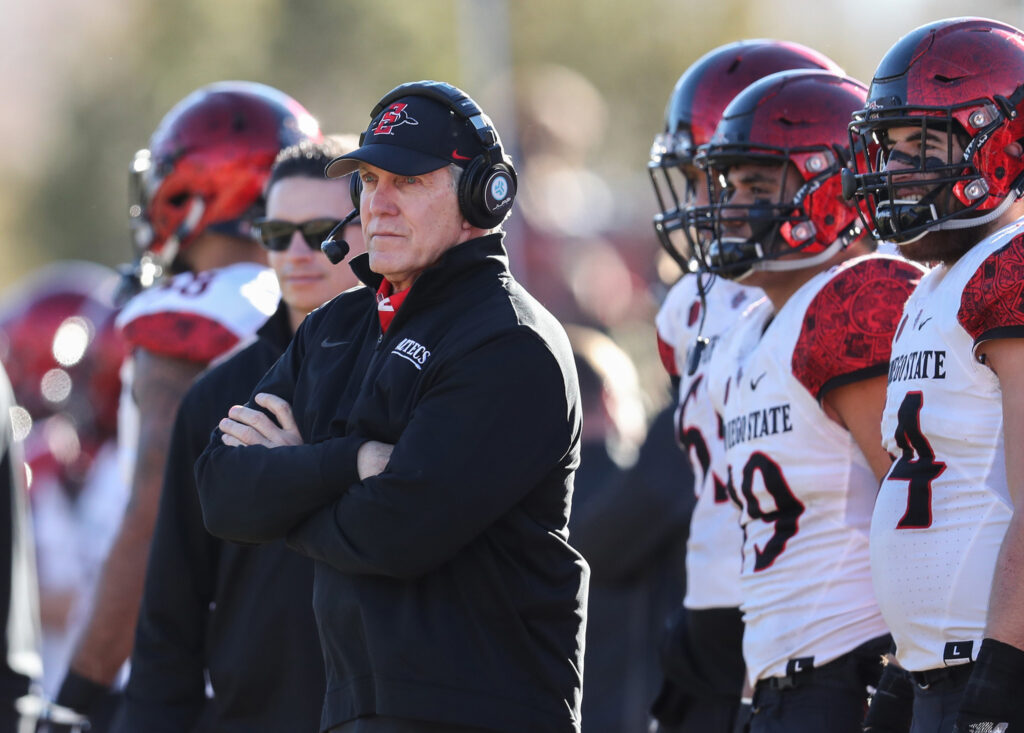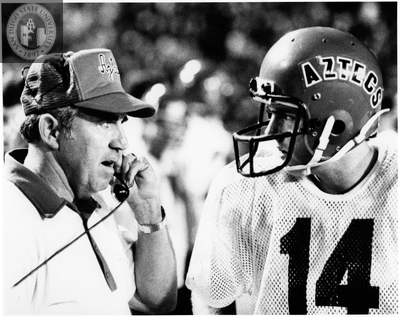Who is the greatest head coach in SDSU football history?

Credit: AP Photo

Only three coaches could lay claim to the greatest San Diego State football head coach’s title: Don Coryell, Claude Gilbert, and Rocky Long.
For all the greatness of Gilbert — taking over for a legend, leading the program in its first Division I seasons, and a .691 winning percentage — he did not coach the Aztecs long enough to make the final comparison. In program history, only Long and Coryell coached for more than 100 games. They are the only two who can claim the honor of the best in program history.
The modern passing game was created in San Diego. Sid Gillman, dubbed “The father of modern-day passing” by longtime Raiders Owner Al Davis, coached the Chargers from 1960-1969. Gillman led the Bolts to the only major sports title in city history, the 1963 AFL Championship. Coryell frequently attended Gillman’s practices and brought what he learned to the Mesa.
Coryell, of course, remains the greatest coach in San Diego sports history. His exclusion from the Pro Football Hall of Fame is absurd. Assistants from his staff at San Diego State — John Madden and Joe Gibbs — are both enshrined in Canton and cut their teeth under Coryell at SDSU. If Gillman brought the passing game to football, Coryell refined it and made it what it is today. Separating Coryell’s legacy with the Chargers and what he did at SDSU is difficult after all these years. Still, his tenure with the Aztecs is the only consideration of this article.
Coryell had a ridiculous 104-19-2 record at SDSU. His teams had winning streaks of 31 and 25 games. Forty-two players were drafted into the NFL. According to players who played at State and went on the NFL, Coryell’s system at SDSU was more rigorous, sophisticated, and innovative than most of the NFL at the time.
“When I first came (to San Diego State as a player) in 1961,” Joe Gibbs said in the book Blood, Sweat, and Chalk, “Don (Coryell) was a killer running coach. I-formation, power running. Just killer. But then it’s amazing the transition that took place. Don switched to throwing it like mad, and he was very creative. He was not afraid to try anything.”
Coryell’s innovation took a program from playing in the 15,000-seat Aztec Bowl to outdrawing the Chargers in the newly built San Diego Stadium. Following the success of Coryell, both on the field and with the adoration of fans, football has gradually shifted from being a game dominated by running backs and the running game to one centered on quarterbacks and the passing game. SDSU hired Coryell in 1961. His last year with the Chargers was 1986. During that time, only nine quarterbacks won the Heisman Trophy. Since 1986, only 12 times has a quarterback not won the award. More than anyone else, Coryell is responsible for that switch.
The shift at San Diego State was just as seismic. From 1949 to 1960, only twice — 1957 and 1958 — did SDSU average more passing yards than rushing yards. When Coryell took over, he continued running the ball. From 1961 to 1963, SDSU had more rushing yards than passing. In 1964, they were nearly even. From 1965 to 2011, the year Rocky Long took over, SDSU averaged more passing yards than rushing yards every year except two — 1976 and 1998.
Fairly comparing coaches from different eras is ultimately impossible. The complexity of factors prevents it, but one area where there is a stark comparison is how these coaches reached their success. In so many ways, the teams under Long fit better in the era Coryell coached in and vice versa. Coryell refined and invented the passing game in a time where most schools followed Ohio State Coach Woody Hayes’ philosophy of “three yards and a cloud of dust.”
Under Long, SDSU averaged more rushing yards than passing yards in six of nine seasons and five in his final six years. Put another way, in the 54 seasons before this past season. The Aztecs were more successful running the ball than passing it in only eight seasons. Six of those occurred under Long. State averaged 502 rushing attempts per season versus only 309 passing attempts in the Rocky Long era.

Long is the only other coach who could conceivably rival Coryell’s success because of his timely impact on the university as a whole. For those who have thankfully forgotten or are too young to recall how horrible the state of the program was before Long coming to the Mesa, one of the most insightful and respected members of San Diego’s media, Mark Zeigler, wrote an article in 2008 titled “A no-win situation: It’s time to drop football at SDSU.”
Zeigler’s opinion ended up wrong only because Long succeeded where no one else could. Arriving at SDSU as Brady Hoke’s defensive coordinator in 2009, Long inherited the team when Hoke left to coach Michigan in 2011. Long was 81-38 at SDSU. He took the Aztecs to a bowl game every year, a streak that was broken the first year he was not the head coach. He won three conference titles. 19 players were drafted into the NFL, and many more entered the league as undrafted free agents.
Yet, it was the circumstances surrounding Long’s tenure which elevated his status and impact. It is doubtful the voters would have approved selling the Mission Valley site to the university without the selling point of a new stadium for SDSU football. SDSU West is one of more important developments in the history of the school. Without the success of the program under Long, there may not have been a team at all. Instead of the promise of an expanded campus, SDSU would likely be neighbors with Soccer City.
Coryell and Long have in common that they chose their offensive philosophies for the same reason: it gave their teams the best chance to bring in talent and win.
“I just decided, hell, you can’t just go out and run the ball against better teams,” Coryell said. “You’ve got to mix it up. You’ve got to throw the damn ball if you’re going to beat better teams. We could only recruit a limited number of runners and linemen against schools like USC and UCLA. And there were a lot of kids in Southern California passing and catching the ball. There seemed to be a deeper supply of quarterbacks and receivers. And the passing game was also open to some new ideas. Finally, we decided it’s crazy that we can win games by throwing the ball without the best personnel. So we threw the hell out of the ball and won some games. When we started doing that, we were like 55-5-1.”
Likewise, Long made SDSU run-oriented — featuring the I formation Coryell invented — because that style of play is so unique in today’s game, other teams have trouble stopping it.
“Rocky has been able to do it like he wants to do it,” Claude Gilbert, who replaced Coryell at SDSU, said. “Get some good running backs and run the ball, play good defense, and to hell with the rest of it. I admire that…If I had started by taking the exact approach Rocky did, they’d have run me out of town a whole lot sooner than they did. Everybody wanted to see the ball in the air.”
Both coaches were brilliant in carving out a niche for their programs in the college football landscape. Coryell was forward-thinking, adopting what he learned from Gillman to revolutionize the game. Long reached back into the past to resurrect a play style that has mostly gone out of fashion. Both found success at a school few others have been able to match, both are the only coaches to lead the program for more than 100 games, and both have left a lasting mark on the university. In the final analysis, which coach was SDSU most fortunate to have leading its program?
Both!
My earliest sport’s memory involve tailgating at the Murph, running down the circular exit ramps, and seeing the Padres, Chargers and Aztecs play. As a second generation Aztec, I am passionate about all things SDSU. Other interests include raising my four children, being a great husband and teaching high school.